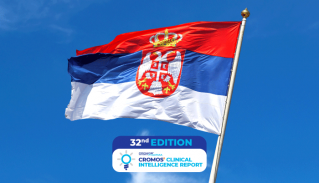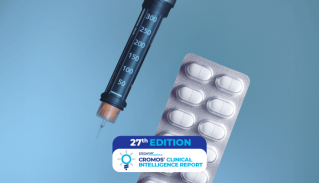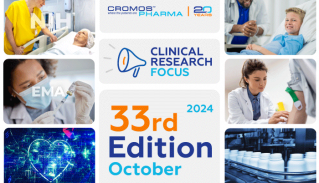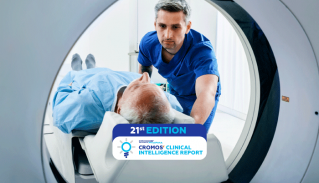
How the EU CTR is Shaping the Future of Clinical Trials: Insights and Key Challenges for Sponsors
The landscape of clinical trials in the EU has undergone a significant transformation with the implementation of the EU Clinical Trials Regulation (CTR). While this regulation promises a more streamlined and transparent approach, it also presents new challenges for sponsors, particularly around managing transparency obligations, navigating complex regulatory processes, and ensuring compliance under the harmonized system. These challenges are especially pronounced for sponsors who may lack the resources or expertise to adapt quickly.
In this interview, Cromos Pharma’s EU Regulatory Lead Monika David shares the latest updates and insights into both the challenges and opportunities that the new regulation brings for sponsors conducting clinical trials in Europe. The interview is conducted by Cromos Pharma’s Marketing Specialist Lilit Tsaturian.
Lilit: Can you elaborate on how the EU CTR harmonizes the clinical trial process?
Monika: First of all, the EU CTR provides a single submission dossier and one electronic portal – the Clinical Trials Information System (CTIS) – where the entire dossier must be uploaded. In the past, for multi-country trials, we had to prepare separate submission dossiers tailored to each country’s local requirements. Now, with the implementation of the CTR, the process is more streamlined with a harmonized format for the Clinical Trial Application (CTA) dossier.
But there are still specific national requirements. EU member states’ authorities and ethics committees expect sponsors to follow local requirements and regulations for CTR Part II submissions because each country has specific legal and ethical standards that must be met. Even though the CTR aims to harmonize the process across the EU, it still allows for national differences to address local concerns.
Based on our experience, we have encountered country-specific requirements for site documents and patient-facing materials.
For example, in Romania, local ECs are still active, and local approval is required for certain sites to obtain a signed site suitability form. While this is not needed for all sites, we have encountered situations where local EC approval was necessary. Similarly, in the Czech Republic, the documents submitted as part of Part II of the dossier follow local templates. Although these are generally based on EudraLex Volume 10 templates, they have been adapted to meet national requirements. In Hungary, for example, it is not required to submit all EMA templates, but the patient card and the protocol signature page must be submitted.
In practice, managing these local differences requires additional research on the specific local CA websites to ensure all requirements are met accurately and promptly.
Lilit: Could you highlight the most significant changes in the EU CTR over the past years?
Monika: As part of the submission process through CTIS under the new EU CTR, revised transparency rules have been introduced. To increase public visibility, certain documents are now accessible to the public. In alignment with this change, sponsors must prepare additional public-facing documents (e.g., Protocol synopsis for lay persons). These documents exclude confidential or personal information but present general details about the trial.
At Cromos Pharma, we fully support sponsors in meeting these requirements. We can provide guidance on the latest regulations and even offer templates to streamline the creation of public documents. This ensures compliance and smooth submission while maintaining transparency with the public.
In addition, it’s essential to note that all previously approved studies – those submitted under the older Clinical Trials Directive (CTD) to local Competent Authorities (CA) and Ethics Committees (EC) and likely to continue after 30 January 2025, with at least one active site – must also transition to the new Clinical Trials Information System (CTIS). This ensures that these studies remain accessible in the new centralized system.
The transition period will conclude at the end of January 2025, meaning sponsors must ensure all applicable studies are successfully migrated into CTIS by this deadline.
Lilit: What challenges have you already encountered with the implementation of the EU CTR?
Monika: Having submitted several CTAs under the new framework, we’ve identified several challenges and tips that could help manage them.
Protocol Requirements:
- Under the EU CTR, the EU CT number must be included in the protocol. This number is only generated once the sponsor and study are registered in the CTIS. This step can delay protocol finalization if not managed early in the process, as sponsors need to coordinate their registration in CTIS well in advance.
- There are countries where it is sufficient to submit a synopsis prepared for lay persons (e.g., Poland), there are countries where the submission of the original synopsis is required (e.g., Hungary), and there are countries where both are required (e.g., Bulgaria).
Fees for Document Review and Evaluation:
- A significant challenge is the lack of a centralized system for government fees across different countries. The EMA has not implemented a uniform platform for payment processing or tracking fee requirements. Each country follows different payment procedures, which complicates the process for sponsors.
- Examples of Country-Specific Procedures:
- Germany: An invoice will only be issued after the evaluation is completed, and it may take up to three months to receive it.
- Czech Republic: Sponsors must submit a paid invoice for the Competent Authority (CA) review, but the Ethics Committee (EC) will issue a separate invoice by email after submission.
- Italy: All payments must be processed through AIFA’s official portal.
- Romania and Germany: Payments must be accompanied by payment commitments with the company’s details and the applicant’s email address, rather than a paid invoice.
- Fee Exemptions: Some countries allow free submission of CTAs, but this varies and must be confirmed on a case-by-case basis.
Managing these differences can be complex, and the involvement of local regulatory affairs (RA) personnel is essential to ensure compliance with each country’s payment rules and timelines.
Given the variety of procedures across the EU, it’s crucial to coordinate early with local RA representatives to avoid delays. Payment-related challenges can significantly impact approval timelines, especially when invoices are issued only after evaluations.
Lilit: The transition deadline is fast approaching. How does this impact the ongoing trials and what challenges did you encounter during the transition of the studies?
Monika: As mentioned earlier, ongoing trials conducted under the CTD must transition to the CTR adhering to updated regulatory requirements and ensuring alignment with the new framework. Considering that the transitional period ends on 30 January 2025, and the expedited 22-day evaluation period offered by the member states was available until 16 October 2024, by now, all sponsors should have already submitted their trials for transition to avoid the risk of not receiving approval in time. For the procedures assessed outside the expedited (22-days) procedure, if Member States Concerned (MSc) create Requests for Information (RFIs) on the Transitional application this can lead to a procedure duration of a maximum period of 106 days, or further in the case of some types of investigational medicinal products.
CTD trials still ongoing and not transitioned at the end of the transition period will be considered non-compliant and in breach with CTR. Also, this could trigger a GCP inspection further.
Although transitioning a trial from CTD to CTR might seem like a straightforward process, it is actually equivalent to an initial submission, as indicated in the CTIS, where the transition submission is marked as initial. Consequently, it involves a significant amount of work and challenges.
Here are some examples of the expectations and challenges we faced during the transitions:
- Expectation: Trials approved under the CTD and likely to continue beyond 30 January 2025, with at least one active site, need to be transitioned. Challenge: It is essential to plan and submit for transition now, as the evaluation process takes time, and delays may prevent timely compliance.
- Expectation: Only the latest CTD-approved versions of the documents should be included in the submission package. Challenge: Identifying and gathering these documents.
- Expectation: Submission of a “minimal” dossier (Protocol, IB, IMPD, GMP Compliance documents, ICF), but member states may request additional CTD-approved documents. Challenge: Deciding whether to submit only the minimally required documents or include relevant documents in mandatory placeholders instead of file notes
- Expectation: Submission of harmonized (identical) or consolidated (containing national variations as a single document) Protocol, IB (or SmPC), and/or IMPD. Challenge: If the sponsor does not have these documents.
- Expectation: All mandatory Part I Structured data sections in CTIS must be completed. Challenge: Ensuring all mandatory Part I Structured data sections in CTIS are completed, or vendors may not be registered in Organisation Management Service (OMS), preventing their entry into CTIS.
Lilit: Despite the structured approach and clear timelines under the EU CTR, are there any nuances or hidden challenges for sponsors?
Monika: The predictability of timelines under the EU CTR indeed offers major benefits for sponsors. The structured deadlines for assessing and approving clinical trial applications simplify project planning and help reduce uncertainty. This clarity supports faster study startups, site initiations, and ultimately accelerates the development and availability of new treatments.
While the standard approval timeline is 60 days—assuming no requests for information (RFIs) are raised—there can still be challenges. Sponsors generally have 12 days to respond to RFIs, and failure to meet this deadline can result in the application lapsing entirely.
We have seen cases where initial RFIs met the 12-day response window, but subsequent RFIs provided much shorter deadlines, especially when the final decision deadline for the entire study was approaching. This decision deadline can be tracked in the Timetable section of the CTIS for each specific study, ensuring sponsors know exactly when a decision is due.
For example, we received an RFI on a Thursday, with a response deadline set for Monday —leaving us only 5 days, including the weekend. In some instances, RFIs were issued on a Saturday, which requires the regulatory affairs (RA) team to monitor CTIS 24/7 to avoid missing critical updates.
Additionally, CTIS does not offer external email notifications for RFIs, meaning that sponsors must log into the system regularly to stay on top of all requests and ensure timely compliance.
Lilit: How do you see the EU CTR influencing clinical trials on a global scale?
Monika: The EU CTR sets a global benchmark for clinical trial regulations. Its emphasis on transparency, efficiency, and harmonization can serve as a model for other regions. By simplifying the process and promoting collaboration, the EU will likely attract more sponsors, which will contribute to global advancements in medical research. Transparency rules, in particular, may become the standard for regions looking to build public trust in clinical trials.
Cromos Pharma’s Expertise in EU CTR Implementation
Cromos Pharma has extensive experience in supporting sponsors through the complexities of implementing the EU CTR. Our deep understanding of the EU’s regulatory framework allows us to guide global sponsors seamlessly through the transition to the new CTIS, ensuring compliance and maximizing efficiency.
If you have any questions or would like to explore how Cromos Pharma can support your clinical trial program under the EU CTR, please reach out via email at inquiry@cromospharma.com. We are committed to advancing your research while ensuring full compliance with the latest EU regulations.






























